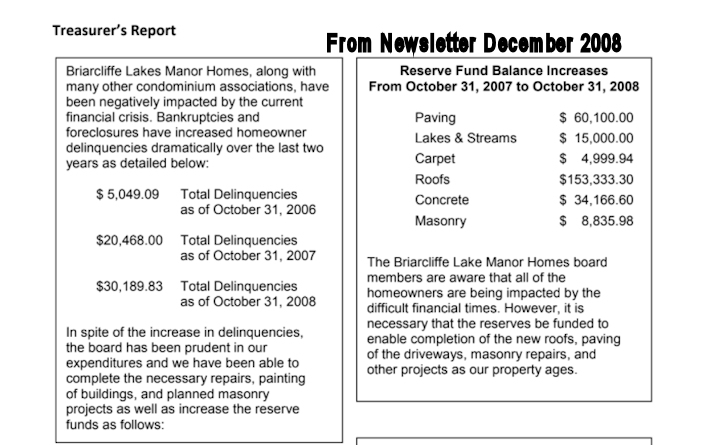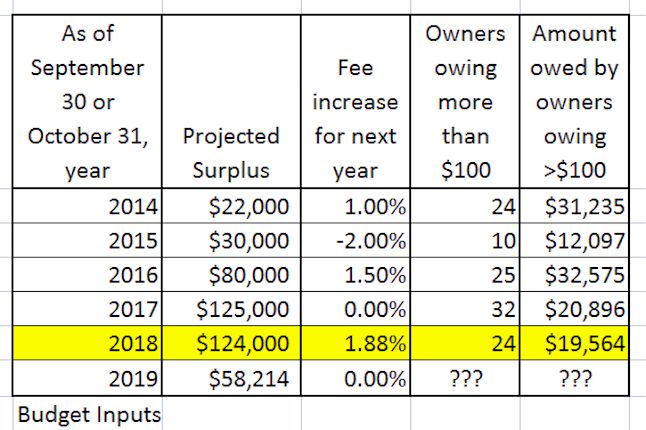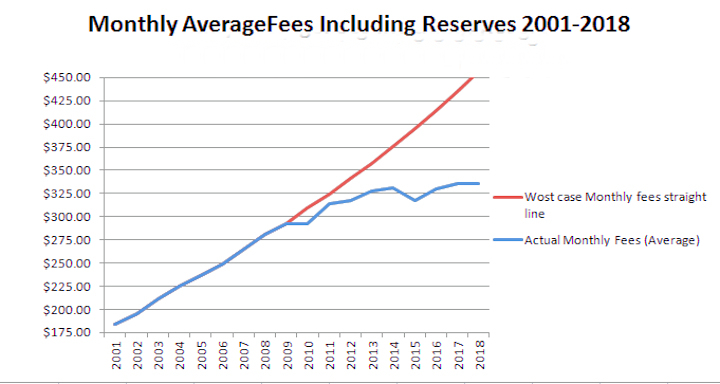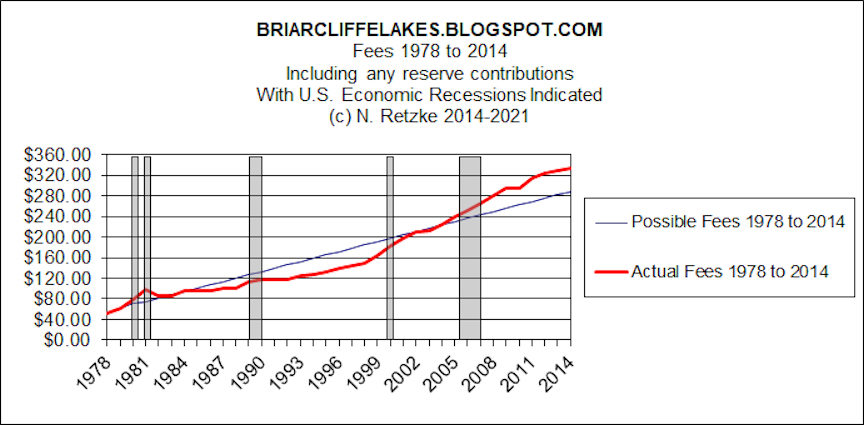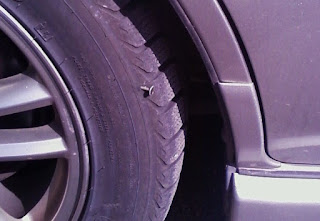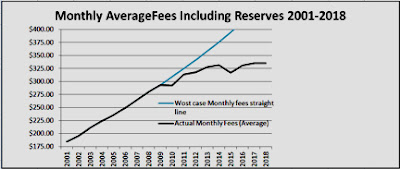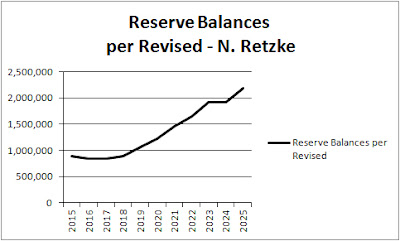
This is
Part Two of a two-part post.
The Roofing Project - A slow death for the Association?
This post includes several charts I prepared for the board and for owners about nine years ago. I prepared these to calm owners. It was one of my first communication steps to inform owners of the plan and the situation.
After ten years of large fee increases and readily apparent infrastructure problems the owners were desperate and frustrated.
Even with a new board in place, two years later the situation at the Association had worsened and by 2010 the full implication of the "Great Recession" in the U.S. was impacting the owners. Bankruptcies and delinquency were a serious problem and becoming difficult for the board to shield owners from. In fact, by December 2011 the delinquencies were more than 6.5% of the annual budget. But that's for another post.
Despite some board assurances, the owners knew the Association was in serious trouble. All one had to do was drive through the potholes on our major thoroughfare, Lakecliffe Drive which sat waiting for someone, anyone, to deal with and correct. And that was the highly visible tip of the iceberg. There had been a steady stream of owner complaints about the condition of the common elements and infrastructure for several years.
In 2007 to 2011, as things spiraled downwards
the roofing project slowly moved slowly forward. There was no publicized completion date and no one had any idea of where fees would top out, or when. There was no overall Association plan. It was chaos, as board members looked for scapegoats, including management. While board members walked, or were fired, the owners were trapped by the economy and in their units.
It is a fact that if an Association ever falls behind with finances, savings and infrastructure it is nearly impossible to catch up. Board failures prior to 2008, and the failure of the new board to act decisively until 2010 aggravated the situation. The "decisive action" was sporadic and inconsistent. That was the mess I took upon myself in September 2010 and I knew it would take at least five years to dig out of the hole (pun intended) which previous boards had created. I openly spoke of this as a "demonstration" of what was possible. I had no illusion about the magnitude of difficulty. In fact, because of a variety of board issues including underminers, the task was made even more difficult.
The following charts provide some background and my intentions for this roofing project. These were produced for board education and owner consumption. What you, the reader, can't be aware of is all of the financial planning and evaluation it took to produce these charts, which were a consequence of my thorough analysis of this
entire association. In 2010 I began with the finances, and then plugged in all of the projects. That required numerous physical surveys and condition reports. I had the balance sheets from previous years; these are sent to all owners, and I had been an owner since 2002. But I lacked certain details. My groundwork for this and all other projects began in earnest in 2010, but it took me almost five years to really get a handle on all of this. All the while I pushed forward with the Roofing Project, and addressed many other infrastructure issues which combined exceeded the cost of the roofs:
 |
| My proposed roofing schedule, prepared in fall of 2010 and after completing my "first pass" thorough review of the finances of this association, with about 80 hours spent on reserves and reserve planning. |
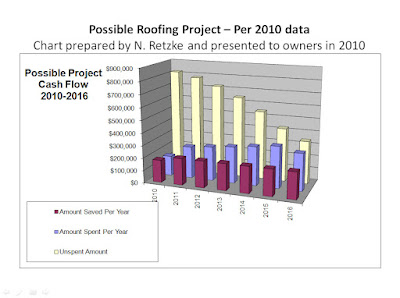 |
My Proposed Roofing Cash-Flow, presented as part of a visual presentation to Owners after a HOA Meeting. This was one of a series of charts covering all aspects of the property
|
The stuff I'm rediscovering as I do the purge includes a copy of a letter. While purging files I came across a copy of a 2006 letter provided by management to an earlier board; it provides some insight.
When I took up the reigns of Architecture, Projects and Maintenance Director in 2011 I made a request of management for historical information about our roofs. I knew the cost per roof, and the number completed to date. What I didn't know was the age of the remaining roofs. These had a finite life expectancy and the clock was running. "To solve a problem it is necessary to identify the problem". I had concerns about the remaining useful life of the roofs.
Management responded and provided me with a copy of a 2006 letter to the board. It was enlightening with insights into the age of the roofs, the schedule of the previous shingling project and the "new" roof scheduling history from 2006 to 2010. I used this information to assess the urgency, and as an aid to develop an accelerated schedule for completing roofs from 2011 and thereafter. The management information confirmed my concerns about the age of the existing roofs. That
2006 schedule history including replacements 2006-2010 indicated the following:
- The earlier reshinging project ran from 1991 to 2000. That project put a layer of shingles atop an existing roof, creating two layers of shingles. The information provided by management gave me the actual dates of the addresses shingled each year.
- The shingling project was followed by a project to completely re-roof. According to the documents that re-roofing project began in 2005, with a single roof. A total of 44 roofs would be completely stripped and replaced with high end, improved architectural shingles, extensive ice and water shield, new gutters, etc. The replacement roof was designed for a life of 20-30 years, with kynar aluminum flashing, etc. The entire roofing protection system was replaced, including the faux furnace chimney. The specifications expanded the ice and water shielding. Roof peak vents were added for improved airflow, and attic insulation was installed. It was an expensive project. According to the specifications I was given and which were in use, everything was to be replaced except the owner's fireplace chimneys and flashing. The owner's fireplace chimneys were left "as is" including the flashing. This because these were not in the specifications and I was told were owner property. Replacing the fireplace chimney flashing would require dismantling and re-constructing the owner's fireplace chimney. The A&M directors who preceded me had left these untouched and "as is" when they did seven roofs. Yet one of these former board members showed up at the September 2018 Association Meeting to ask me why I hadn't replaced the fireplace chimney flashings as part of the roofing project. Let's be real here. He oversaw the replacement of several roofs, but wanted to know why I had not changed the specifications he actually used. LOL!
- Over a period of six years, from 2005 to 2010 seven roofs had been done. It would be left to me to figure out how to do the remaining 37 and quickly.
- Over the entire project three or four different roofers were the successful bidders. During the period I was on the board, September 2010 to the completion of the project, all bids were via sealed packages. Up to five qualified bidders were solicited by management and asked to compete each year. Specifications previously prepared were used. (I assumed a board position in September, 2010). One year I stripped the bidders name from the bid comparison documents, for board discussion purposes. After all, each of the bidders had been selected according to a rigorous criteria. I wanted the discussion to be about the merits of the bids, not the NAME of the bidder. I had a concern that one or more former and current board members had an agenda and might influence the selection process. There was a clique of long term current and former board members. So the bidders were referred to as "A", "B", "C", etc. in my spreadsheets. A former board member objected to this approach.
- According to the history documents the first roof selected for replacement had been reshingled in 2000, yet it was replaced in 2005. That was at 1775-1777 Gloucester, which was the address of the president of the Association.
- Four years later, in 2009 two roofs were replaced. These were 1605-1607 Thames and 1730-1732 Harrow. The board had been discussing replacing one roof. But in June I took a photo of a failing roof at 1730-1732 and sent it to management and the board. (I was a mere owner with no formal duties or board responsibilities). I expressed my concern about the condition of that roof with the board. The A&M director agreed and the board decided to replace that roof, thereby increasing the scope for 2009 to two roofs. I also expressed concerns about the pace of the project which could result in roofs with shingles 25-30 years of age (I was guessing, based upon the limited information available to me as a "mere" owner). If that were to happen it would be a problem, with leaks, etc. The board publicly stated that they would deal with this by repairing roofs if necessary, rather than replace. Of course, winter repairs are not easy to accomplish and roof leaks can inconvenience residents and create expensive interior repairs. I gave the opinion that repair of any roof soon to be replaced is a waste of fees (paid by owners).
- In 2010 a new board and a new A&M director decided to do four roofs. These were 1739-1741 Harrow Ct., 1700-1702 Lakecliffe Dr., 1758-1760 Plymouth Ct. and 1780-1782 Gloucester Ct.
- In 2011 I took over the project with the departure of that A&M director. Seven out of 44 roofs, or about 15% had been completed. 85% of the roofs remained, some 20 years old and beyond end of expected lifespan. That was a serious problem because we had 13 at the end of useful life. We had many more aging roofs. I reviewed the specifications and made some minor adjustments. For example, roof vents were added for all interior bathroom fans. I was aware that one roofer had voluntarily done this earlier, of his own accord, even though not in the specifications. The fans were currently venting into the attic space; not a good procedure as it pumped a lot of moisture into the attic cavity.
 |
| June 2009 Failing roof 1730-1732 Harrow. My photo was sent to management and the board, who were completely unaware of this problem because it could not be observed from street level. There are supposed to be two layers of shingles on this roof. I only see one. Had the previous roofer cheated the association? With no project management, this is what we got! |
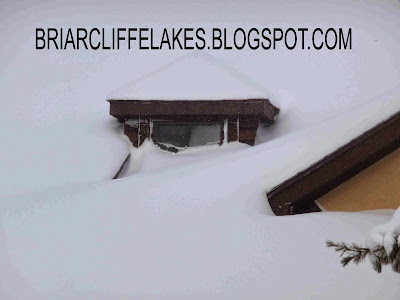 |
| Buried Dormer Window - A real problem for leaks in through the windows |
 |
| Ice Dams and Icicles |
 |
| Icicles, and some snow removed manually |
In 2011 when I assumed my duties there were 37 roofs waiting to be done. The history documents indicated these had been been shingled with a second layer in 1991 to 2000. At a rate of four per year, the roofing project would be completed ten (10) years later, in 2021. This posed several issues for me, and a serious problem for the Association:
- If the project were completed at the current pace and allowed to stretch out until 2021, some roofs could be 30 years of age, while others might be 21 years of age. My financial planning indicated that with the current fees it was possible to complete all by 2016 or 2017 while other capital project issues including Lakecliffe were also addressed. The age of the remaining, existing roofs in 2016 would be between 21 and 25 years.
- The predicted lifespan of the existing roofs was 18 to 20 years. It would be a stretch to delay completion until 2016. It would also be a financial stretch to complete by 2016! This I would consider to be an example of being caught between the proverbial "rock and a hard place."
- While it would be preferred to replace the oldest roofs first, we also had to keep an eye on the current condition of all of the roofs.
- How to select the roofs each year? I discussed the issues with the board. I wasn't willing to wait until leaks appeared. I walked the property and made visual inspections of each of the roofs every year. Also after any severe weather. I visually inspected fronts and rears using a telephoto lens or binoculars. I directed management and our maintenance contractor to advise the board of any and all leak issues. I asked that these be logged with work orders; all work orders go to the board each month and creating them would provide an improved history of issues. I tracked these problems from 2011 to 2016 and reported frequently to the board.
- With the above information the replacement would be based primarily on condition.
- How to avoid expensive failure of those old roofs? How to avoid wasting association money on temporary repairs of old roofs? We were racing the clock.
- How to do this project fairly with no bias? One thing I did was to put the roof at the address of my unit to the end of the list. Probably a new approach at BLMH, where owners were trained by boards to come to meeting and press for improvements and got them. "The squeaky wheel gets the grease" is the way it was done.
- How to get it done with the reserves on hand and with the current fees? Earlier boards had crippled the Association via inadequate reserves and a very large maintenance (capital improvement) backlog. Over a period of 11 years, from 1998 to 2009 the boards ramped up fees at an average annual rate of 6.85%. Owner fees nearly doubled over that period, reaching about $295 per month in 2009. Simultaneously, the boards prior to 2009 had stopped a lot of other capital work on the property, in an attempt to accumulate the necessary funds. They were certainly aware of the financial issues, ergo the slow pace of the roofing project and those relentless fee increases.
- Over the next 9 years, 2010 to 2018, the fee increases stabilized, totalling 14%, an average of 1.56% per year. The eight years I was on the board the average fee increases were 1.75% each year (Oct. 2011 to Oct. 2018). See the Notes at the end of this post and the link at the end of this post for the BLMH.org website data.
- How to do it based upon "cash flow" which in this case is the amount of reserves in 2011, the other items in the maintenance capital project backlog, and the amount of cash contributed to reserves each year from 2010 and beyond?
- How to do it given the logistical issues. What are the practical limits to the number of roofs each year? How to coordinate with other projects, including the annual painting/exterior repair cycle, the street projects, driveway replacements, stream repairs, garage repairs, water mains and so on. A lot, and I do mean a lot of coordination was required. While I was doing this, some on the board coasted, preferring to attend meetings and vote to complete roofs.
- How to simultaneously address other problems such as the failing streets? These had been replaced in 2002-2003 but by 2007 Lakecliffe Blvd, our major thoroughfare, was failing with annual repairs necessary. Some irate owners called it a "Mine Field". Of course, I pointed out that this was created by earlier boards, but that fell on deaf ears. Some owners were really nasty to me.
With the assumption of these duties, I formulated a realistic plan:
- I tracked all association maintenance and infrastructure problems and rated them as to severity. This coupled with annual inspections would provide some guidance as to condition of the roofs and their decline year over year.
- Using the information, I created a more thorough, specific schedule.
- The schedule was updated annually as determined by current conditions.
- Roofs were prioritized based upon condition and problems experienced.
- The schedule was accelerated. Four roofs in a year, then six with a peak of eight completed in a single year.
- We began doing interior roof inspections when an issue was reported to determine if there was any evidence of other leaks, etc. By 2014-2015 we had made interior inspections of all roofs.
- The schedule was compared to the 2010, 2011 and 2015 reserve studies.
- The allocation of reserve resources were targeted to the roofs and the streets, while prioritizing other projects. Some board members argued each and every year for higher fees ("at least 3% per year"). However, the numbers simply didn't support their arguments. The ten- twenty- and 30-year plans indicated we were on track.
- In 2010 I published a plan to complete all of the roofs by 2016. By 2016 some existing roofs could be 25 years of age. Those roofs were designed for 18 to 20 years. Which is precisely why so much observation and monitoring was necessary.
- I also told the board that in my opinion, any repairs to old roofs (shingles older than 20 years) was a waste of Association funds. Those roofs had reached or exceeded life expectancy and really should be replaced. Repairs would be a stop-gap, last resort approach.
- To avoid problems winter snow was removed from some portions of roofs in an attempt to prevent ice dams from forming. For high areas a lift was rented so workers could get to those areas. In practice owner fees were spent on additional roof maintenance attributable to the age of the roofs. This was one of a number of hidden costs because of the delays to the roofing project.
- All of these steps were generally successful, but by 2015 we were experiencing increasing problems with the old roofs.
- The roof on the building which houses my unit was re-shingled in 1993. It was replaced in the last year of the project, at the age of 24 years. We were cutting it very close! I deliberately avoided doing that roof until the end and based upon condition. It was "fair" condition by 2015, but there were no leaks. I wanted to avoid the purported favoritism that occurred in the Association from time to time, and I did.
- Dealing with the roofing project issues did increase my workload substantially. It took a lot of planning on my part to figure out a way to juggle all of these project problems and stabilize fees with the current finances.Which is one of the reasons my "volunteer" hours quickly ramped up to 1,100 per year. I think some of the old board loved watching my struggle with the problems that they had created. Of course, owners were struggling with the nearly doubled fees. No one wants to really talk about the foreclosures and bankruptcies among owners.
- I pressed the board to pay for proper project management oversight to this expensive and critical projects. I pressed for fully qualified, known, licensed, bonded and insured professionals. I pressed for engineered drawings and specifications, prepared by professional engineering firms. Our professional management company is not our engineer, our accountant nor our project manager. Yet, previous boards and even some current, longtime board members pressed management to provide such services. One board member pushed to throw management "under the bus" clearly stating that she/he would see to it that they were fired if they didn't go along with the agenda. And owners wonder why Lakecliffe failed after five years? Duh!
Here's an image of the spreadsheet data I created in Spring of 2011, based up Work Order reports of roofs which experienced issues. Each month I added the addresses from the current list of work orders so a decision could be made in the spring about which roofs to inspect further, and to replace in that specific year. A variety of professionals made more detailed inspections, both inside and outside the roofs.
There were similar sheets created by me for five years. These sheets were intended to aid me in guiding the board to make the best possible decision. The colors are matched to a plan of the association, which shows the precise location of the buildings on the spreadsheet. That map was used to coordinate painters, driveway replacement and other contractors and to avoid logistical conflicts. Such conflicts may increase the costs to the association.
 |
| Spring 2011 Spreadsheet Summary of Work Orders pertaining to roof leaks |
 |
| Location plan, color coordinated with the spreadsheet. |
Another issue appeared as I was assuming the A&M duties. The first roof, the one replaced in 2005 at 1775-1777 Gloucester had gutters added along the sides of the building. This was in the specification used for all other roofs. However, that roof also had a special treatment to deal with the gutter discharge, which had been relocated from a point on the driveway to adjacent to the front entrance.
To deal with this, at 1775-1777 an underground storm drain line was added to carry the gutter discharge away from the building. Unfortunately, that was not done at
any of the subsequent roofs. As a consequence, by the fall of 2011 we were getting complaints of ice at entries, and heaving walks. In fact, a brand new driveway heaved and lifted about 1 inch and that walk cracked because of freezing water running beneath it from a newly relocated gutter (that was done prior to 2010 and my tenure, but I did observe the problem and I knew we had a major issue to deal with).
With 84 building entrances, any common problem due to construction approach, techniques used and decision quickly escalates to serious costs. By 2011 we had a backlog of 20 entrances to deal with. And more were being added to the list each year. A variety of approaches were selected to deal with this. Of course, this was all a consequence of the roofing project, and the total cost of that project did increase. Some of this was handled as a maintenance issue, but a lot was dealt with via reserves, as it should be.
We did also experience "wing wall" foundation issues at several addresses. These too had to be addressed, as a column supporting the roof was resting on these foundation walls. Were these problems attributable to water deposited at entrances by relocated gutter downspouts?
By 2012 I had come up with a plan with maintenance of how to address the water at the entrances. We had a backlog of new roof related problems to deal with. It took until 2018 to catch up and address all of these issues. Sadly, the earlier boards had known about this problem but failed to address it and also failed to communicate it to the boards that followed. That's an example of what I call "undermining" of future boards. This could be accidental. Communications is not the best with some boards and board members. However, I do know that there was animosity for new boards after the "palace coup" of 2008.
Here is an example of the consequence of changes, oversight and communications or the lack thereof. I only learned of this problem when the "A" unit at 1730 Harrow Ct. was flooded after a new gutter was installed. It discharges at the corner of the building which was a low point. Water deposited by the gutter built a pool in the corner. The pooling water rose above the foundation line and seeped into that unit. There had never been a gutter or a discharge in that location.
Communications is important, but not all board members think so. There are real consequences to poor communications, but I've been unable to convince everyone on our boards of that;
c'est la vie.
 |
| Drainage required by new gutter and downspout installed in 2009 with a new roof at 1730H. Drainage added after the unit was flooded. Photo taken in 2011. |
 |
| Drainage required by new gutter installed in 2009 at 1730H, added after the unit was flooded. Photo taken in 2011. |
NOTES:
- The 2017 fee increase was 1.5%. That year the Association had a budget surplus of $51,035 as of 12/31/2017. Is that significant? Had the fees been 4.08% lower we would have had a balanced budget. In other words, the fee increase of 2017 was unnecessary. That was my position when we were making that budget in October-November of 2016. As a "compromise" the board agreed upon a 1.5% increase. As of September, 2018 a budget surplus was projected for 12/31/2018; the actual surplus or deficit remains to be seen, and only after all 2018 bills are in. We had a 0% fee increase for 2018, and that board decision was accomplished because of the surplus of 2017. It became impossible for the "We need higher fees" promoter on the board to win that argument in the fall of 2017 because of the budget surplus of the prior year. Better budgeting yields better results, and that means better decisions are possible.
- I was involved on the board from September 24, 2010 through September 27, 2018. During my tenure average annual fee increases were 1.75%, and a substantial amount of planning was accomplished. That was a result of many board actions during that period. My peak 1,100 hours each year were spent well. More on this in a later post.
- The question owners don't ask, and even some board members don't ask, is this: "Where does the "budget surplus" money go?" Board members really should know the answer, and I can guarantee that all don't know the answer to this question.
- I became aware of a clique of current and former board members, run by our Association's most senior board member. After numerous attempts to sabotage or undermine other board members I reluctantly concluded there were both current and former board members who should not be trusted. Beware being "thrown under the bus".
- The following links to the "official" 2018 budget, which shows the 2017 budget, approved 2018 budget and the "projected" 2018 year end as of September 2018. In 2018 the treasurer and I asked management to provide several budget updates during the year, as part of our drive for tighter and ultimately better and more accurate budgets. "Better" budgets I define as 1) more useful and 2) less likely to result in poor decisions:
